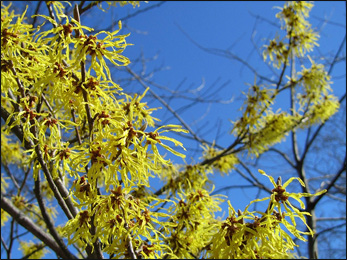What are the Uses and Health Benefits of Witch-Hazel (Hamamelis Virginiana)?

Introduction
Hamamelis virginiana is a species of witch-hazel and also known as common witch hazel.
It is a fall-blooming, deciduous shrub or small tree which is native to eastern North America.
Scientific Classification
- Kingdom: Plantae
- Clade: Angiosperms
- Clade: Eudicots
- Order: Saxifragales
- Family: Hamamelidaceae
- Genus: Hamamelis
- Species: H. virginiana
- Binomial name: Hamamelis virginiana
- Common name: Common witch hazel
Description
It is a small, deciduous tree which is growing up to 6 m (rarely to 10 m) tall.
- Bark - The bark of this tree is light brown, scaly, smooth, inner bark reddish purple. The branchlets are light orange-brown, have a hairy surface at first but later becomes smooth. Then marked with irregular white dots and finally become dark or reddish brown in color.
- Leaves - Leaves are simple, alternate and bright to dark green in color. The shape of leaves are obovate to elliptical with an irregular base and margins of the leaves are coarsely notched. The new leaves appear reddish-bronze in color. Autumn leaves are clear yellow in color.
- Flowers - The flowers are pale to bright yellow in color, but rarely appear in orange or reddish color and crinkled with four ribbon-shaped petals. Flowers have a light and spicy fragrance. The blooming time of flower is in October and November after the fall of foliage.
- Fruits - The fruits are long and hard woody capsules. These capsules take one year to become mature and these are 10–14 mm long.
- Parts Used - Leaves, Bark
- Regions - Mountain, Piedmont, Coastal Plains
Chemical Constituents
Leaf Contains:-
- 3-10% tannins: It includes a mixture of catechins, gallotannins, plus cyanidin and delphinidin type proanthocyanidins.
- Catechins: It includes (+)-catechin, (+)-gallocatechin, (-)-epicatechin gallate, (-) epigallocatechin gallate)
- Phenolic acids: It includes caffeic and gallic acids.
- Flavonoid: It includes galactosides and glucuronides and flavonoids such as kaempherol, quercetin, quercitrin, and isoquercitrin.
- 0.01-0.5% volatile oil: Among which 40% are aliphatic alcohols, 25% carbonyl compounds, 15% aliphatic esters, and a maximum of 0.2% safrol
Bark Contains:-
- 8-12% tannins, free gallic acid, condensed catechin tannins, and a small number of flavonols, 0.1% volatile oil.
- The bark contains higher amounts of phenylpropanoids and sesquiterpenoids in the volatile fractions as compared to the leaves. The leaves contain higher amounts of monoterpenoids. The bark contains hydrolysable tannins and the leaves largely contain condensed tannins.
Health Benefits
Hamamelis virginiana may offer various health benefits. The leaves and bark of Hamamelis virginiana are used in the preparation of teas and ointments.
Relieves Inflammation
Hamamelis virginiana (Witch hazel) have potent anti-inflammatory properties and includes gallic acid and tannins. So this plant may be beneficial in the treatment of inflammatory conditions like eczema, acne, or psoriasis.
Hemorrhoids
Hamamelis virginiana (Witch hazel) is usually used as a natural remedy for hemorrhoids. So, Hamamelis virginiana is used to reduce the itching, pain, redness, bleeding, and swelling caused by hemorrhoids.
Acne
It has a powerful anti-inflammatory property and may be beneficial in the treatment of acne. Witch hazel also acts as an astringent which helps to shrink pores, calm your skin and reduce inflammation.
Soothes Sore Throat
Due to its anti-inflammatory and astringent property, it can be sometimes beneficial in the treatment of sore throats.
Prevent Infection
Some research studies show that witch hazel may have antiviral effects, so it can fight against certain types of viral infections such as influenza A and human papillomavirus (HPV).
Alleviates Scalp Sensitivity
Applying witch hazel to the scalp before washing your hair may help to treat the sensitivity of scalp and also reduce the scalp irritation. Sometimes witch hazel is used to treat dandruff and dryness of the scalp.
Treats Bug Bites
Topical application of witch hazel on the skin after an insect bite shows a beneficial effect. Mix witch hazel with an equal amount of water or in other carrier oil and then apply on affected skin. This can help to heal the wound and protect the affected area from infection.
Heals Respiratory Tracts
Witch hazel in the form of tea provides a positive effect on the respiratory tract. It helps treat inflammation of the esophagus, sinus infections, irritation from coughing, and tonsillitis. Witch hazel tea can be used as a gargle for quick relief. This can help to eliminate the soreness and pain, and also drying up the excess mucus.
Relieves Headaches
Witch hazel has an astringent property which helps to soothe headaches. Topical use of its extract can reduce the tension of the small capillaries that usually cause headaches. Witch hazel tea also reduces blood pressure.
Side Effects
- Allergic reactions.
- Witch hazel water has a high content of tannins so it may be toxic on oral consumption.
- Minor skin irritation
- Stomach upset when taken by mouth
- Large doses might cause liver problems.
- Witch hazel also contains a cancer-causing chemical i.e. safrole but in a very small amount.



